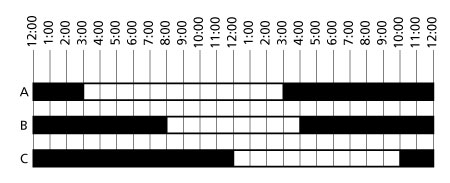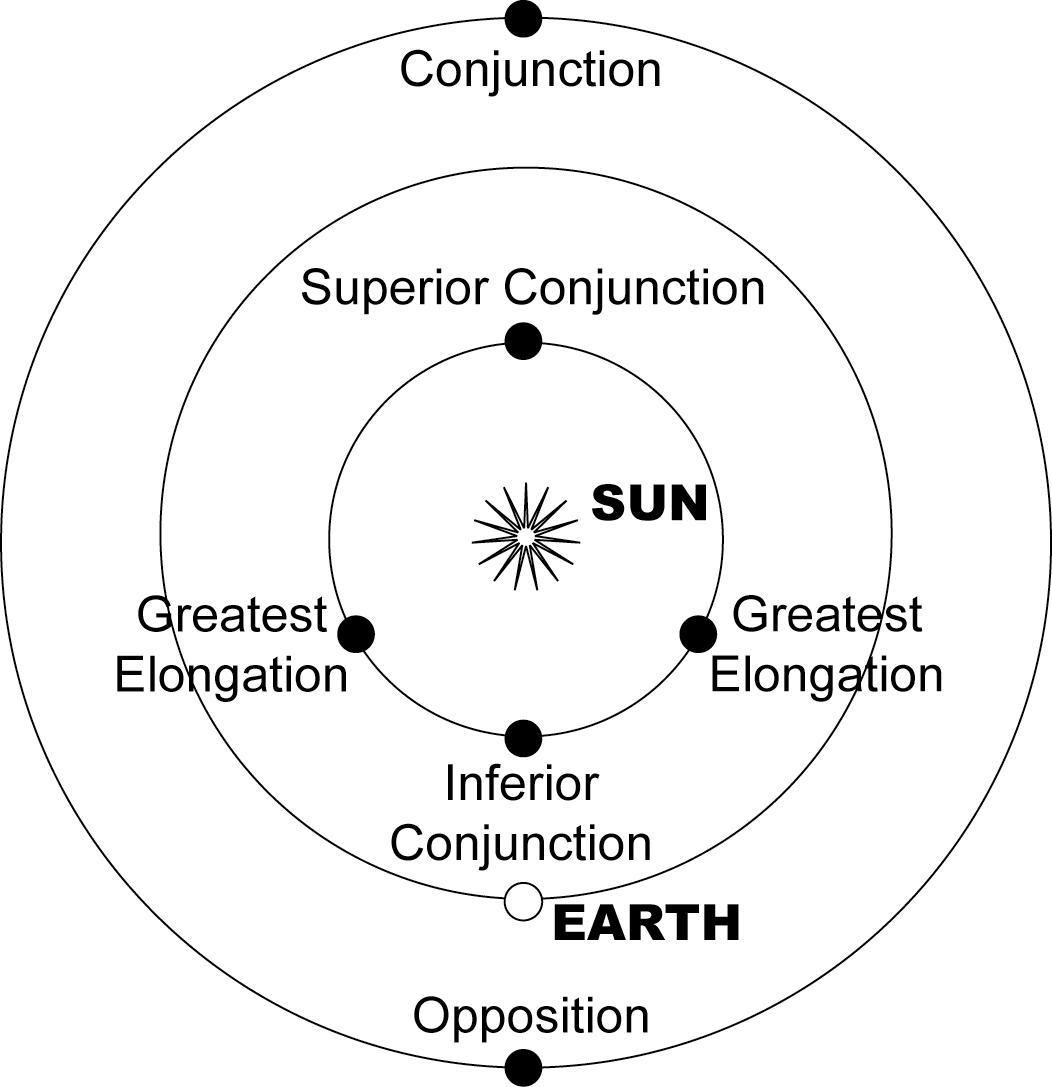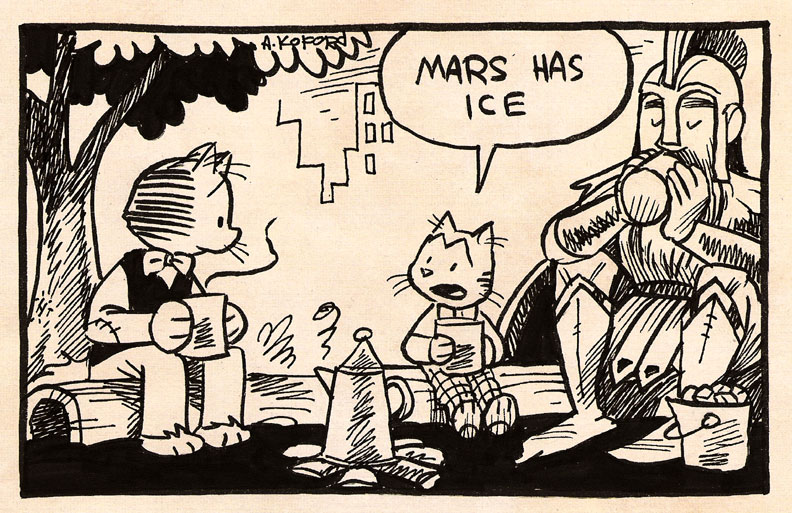Author Archive
 Mercury at Greatest Elongation 2007
Mercury at Greatest Elongation 2007
Although Mercury is often in our sky and listed as being “visible,” it’s usually quite hard to find. As the closest planet to the Sun in our solar system, Mercury is only visible just after sunset, or right before sunrise. This means that you’re looking for Mercury low in the sky – through whatever muck is in the atmosphere – and through dimming twilight, the hardest time of night to see anything. It’s not light enough to see objects on Earth, and it’s too light to see the stars. To see Mercury you usually have to know exactly where to look.
Get ready, because this will all be different very soon! On February 7, 2007, Mercury will be at “greatest elongation,” the furthest it ever gets from the Sun from our point-of-view. So, it might actually be completely dark when you’re looking for it.
Where to Look:
Between 5:00pm and 5:30pm, look in the southwest region of the sky. Venus will also be visible during this time (in fact, Venus will be the brightest thing you can see in that area). Mercury is just a little further west and a little closer to the horizon, in the constellation Aquarius.
Vocabulary:
What always frustrates me about “greatest elongation” is that I get it confused with all those other orbital vocabulary words. Let me see if I can set them straight.
Greatest Elongation: When an object appears in our sky to be as far from the Sun as it can possibly get. This only happens to inner planets.
Perihelion: Point in an object’s orbit closest to the Sun.
Aphelion: Point in an object’s orbit furthest from the Sun.
Opposition: When the Earth is directly between an object and the Sun – opposite from the Sun. (For instance, during a lunar eclipse, the Moon is at opposition).
Conjunction: When an object is in approximately the same part of our sky as the Sun in conjunction with the Sun. There are two kinds of conjunction: When the Sun is directly between the Earth and a body (superior conjunction), or when a body is directly between the Earth and the Sun (inferior conjunction).
Want More?
http://en.wikipedia.org/wiki/Astronomical_opposition
Where’d I Get My Info?
http://en.wikipedia.org/wiki/Astronomical_opposition
![]()
~ A l i c e !
 March Lunar Eclipse
March Lunar Eclipse
June 2010: I feel the need to update this. Below I mention two lunar and two solar eclipses each year. Poking through some predictions of future eclipses I’ve found four lunars in 2009 and four solars in 2011. Other than that, there do seem to be two a year. Now I have to figure out exactly why, but my suspicion is that it has to do with perfecting the math, and that a lot of those “extra” eclipses are not total.
Original Post:
Here’s some news ahead of time for you. On March 3, 2007 there will be a total lunar eclipse. Unfortunately, it will be best viewed from the middle of Africa. Here in Seattle, we’ll see just the tail end of the eclipse which will appear as a dark shadow covering a small section near edge of the moon as it rises at 6:00 p.m.
Luckily for us, there are two lunar eclipses a year! On August 28, 2007 we’ll get to see the whole show – a total lunar eclipse best viewed from the West Coast of North America.
Before you read the next part, I have a caveat to mention: everything depends on where you’re standing. If you were standing above our solar system, you would see that the Earth goes around the Sun, the Moon pretty much goes around the Earth, and the Sun doesn’t go anywhere. If you were standing in the middle of the galaxy, you’d see all that, but the Sun would be traveling around the galaxy also. From standing on Earth, it looks like the Sun moves around us, even though it doesn’t. Since we’re talking about observing eclipses, what it looks like from Earth is more important than what it looks like from outer space.
Why are there Two Lunar Eclipses and Two Solar Eclipses Each Year?
Update, according to Mr. Eclipse (who I trust, since NASA does) there are between 2 and 5 solar eclipses each year. I ASSUME this means there are between 2 and 5 lunar eclipses as well.
Take any two rings of approximately the same size: two hula hoops, two key rings, the two rings from an embroidery hoop, or two bangle bracelets. I’m going to use hula hoops.
If you stand inside the hula hoop, you’re the Earth, and the hoop is the path the Sun follows as it seems to travel through your sky, the ecliptic. The Sun takes one year to trace this path. Now, stand inside the other hula hoop. This is the path the Moon travels through your sky. It’s very close to the ecliptic, but isn’t quite the same.
Time to use your dexterity! Using both hula hoops, hold them together, one on top of the other (Image 1). They should be touching all the way around. Now, tilt one a little. The one you’ve tilted should go down through the middle of the other (Image 2). These are the Sun’s path and the Moon’s path. How many places are they touching?
The Sun’s traveling along one hoop, crawling 1/12th of the way around the hoop every month. The Moon is zooming around the other hoop, covering the entire distance in one month. When the Sun finally arrives at one of the intersections (a node) it will still be there when the Moon gets to the same intersection, since it’s moving so slowly. This is a Solar Eclipse. Two weeks later, the Sun hasn’t moved much, and the Moon is at the opposite intersection (node) forming a Lunar Eclipse!
There’s a lot more to tell about eclipses, I’ve simplified a little, but that’s the basic reason we have two of each per year.
Want More?
http://www.mreclipse.com/MrEclipse.html
Beautiful and Artful Photographs of Lunar Eclipses by Laurent Laveder (http://www.pixheaven.net/photo.php?nom=060907_1926)
Where’d I Get My Info?
Eclipse Predictions by Fred Espenak, NASA/GSFC (Mr. Eclipse himself)
http://skytonight.com/observing/objects/eclipses/3304006.html\
http://sunearth.gsfc.nasa.gov/eclipse/eclipse.html
http://aa.usno.navy.mil/data/docs/UpcomingEclipses.html
 Chandra Sees Kepler’s Supernova
Chandra Sees Kepler’s Supernova
Four hundred years ago Johannes Kepler (the same Kepler who gave us Kepler’s laws) saw a new bright star in the sky: a supernova. Obviously, Kepler couldn’t take a photo of it, but he did take detailed notes. Those notes have allowed us to determine where in the sky we should look to see the remains of “his” supernova. Interestingly, this remnant has been puzzling current astronomers as much as it puzzled Kepler – even with all our new instruments.
The puzzle is this: what kind of supernova was it? Supernovae come in two basic flavors: Type Ia and Type II, and scientists can’t tell which Kepler’s was.
Type Ia:
Type Ia supernovae occur when you have two stars orbiting in a binary system: a white dwarf star and a larger companion star. If they’re close enough together, gasses fall from the bigger star onto the white dwarf, and if this happens too fast, the star explodes
Want More?
http://imagine.gsfc.nasa.gov/docs/introduction/supernovae.html
 Polaris: A Cepheid Variable
Polaris: A Cepheid Variable
Polaris, the North Star, the 49th-brightest star in the sky, is a Cepheid variable star. Cepheid variables proved that galaxies are huge and far away instead of small and close by.
Why Stars Are Big:
A star stays star-sized the same way a balloon stays balloon-sized: competing forces. In the case of a Helium balloon the Helium is pushing out, trying to escape from the balloon. If it weren’t for the air around the balloon, it would explode – allowing the Helium to escape. The air (the atmosphere) is pushing back on the balloon, trying to flatten it.
In the case of a star, the energy from the fusion reaction at the core of the star is pushing out, keeping the star big, and gravity is pushing in, trying to collapse the star into a neutron star or black hole. As long as the fusion keeps going, the star stays “inflated.”
Pulsing:
Unfortunately, Cepheids have finished fusing all of their Hydrogen into Helium. The next step is to fuse Helium into Carbon, Nitrogen, and Oxygen – but that reaction is hotter and takes more energy to start – energy the star doesn’t have. Since there’s no longer fusion happening in the star, gravity begins to win. The star starts to collapse: squishing all the atoms in the star closer together.
But wait! Squishing releases heat and energy! Suddenly, the star has enough energy to fuse some Helium into other elements. Fusion begins. The energy from fusion pushes out on the star, and the star expands again – losing energy and heat. Sadly, there is no longer enough energy to keep fusing Helium so fusion stops. The star begins to collapse again – releasing heat, energy, and fusion! This pushes out – heat is lost – fusion stops – the star squishes – heat is gained – fusion starts – the star expands … etc, etc, etc.
What Does This Have to Do with Galaxies?
In Cepheids, the speed of the pulsing is related directly to how bright the star is (a period-luminosity relationship). So, if you know how fast a star is pulsing, you know how bright the star really is (not how bright it looks in the sky). Then, by measuring how bright the star looks you can figure out how far away it must be. It’s like a flashlight: if you hold the flashlight and shine it in your face it’s very bright; but if you have a friend hold the flashlight at the other end of a football field and shine the flashlight in your face, you can look right at it: it looks dim.
In 1912, Henrietta Leavitt measured a bunch of Cepheids in the Small Magellanic Cloud and realized that they were too far away to be within our galaxy. Astronomers realized this meant that some things they thought were small might be large and very far away: galaxies.
There are some problems with measuring the distance to galaxies this way, but it got us started.
Want More?
http://zebu.uoregon.edu/~soper/MilkyWay/cepheid.html
Where’d I Get My Info?
http://imagine.gsfc.nasa.gov/docs/science/mysteries_l1/cepheid.html
http://zebu.uoregon.edu/~soper/MilkyWay/cepheid.html
 Winter Solstice 2006 — Dark Days of Winter
Winter Solstice 2006 — Dark Days of Winter
It’s cold. It’s dark. It’s wet. There’s no fresh produce. It’s clearly time for a celebration.
It’s the winter solstice. This year (2006) the solstice occurs just after midnight at 12:22 a.m. between Thursday, December 21st and Friday, December 22nd. You may already know that the winter solstice is the shortest day of the year, and here are some other cool facts that you may not know.
Dark Days of Winter:
The United States Naval Observatory (USNO, a reliable source for all kinds of astronomical measurements) brought the “Dark Days of Winter” to my attention. Although the winter solstice is the shortest day and the longest night of the year, it’s not the day that the sun rises latest or the day the sun sets earliest. The earliest sunset happened two weeks ago on December 5th. Unfortunately, even after the solstice it’s going to continue to become harder to get up in the morning because the sun will be rising later and later all the way until January 3rd.
| Date | Sunrise | Sunset | Hours of Daylight | |
| December 5th, 2006 | 7:41am | 4:18pm | 8 hours and 37 minutes | Earliest Sunset |
| December 22nd, 2006 | 7:55am | 4:20pm | 8 hours and 25 minutes | Shortest Day |
| January 3rd, 2007 | 7:58am | 4:30pm | 8 hours and 32 minutes | Latest Sunrise |
| January 4th, 2007 | 7:57am | 4:31pm | 8 hours and 34 minutes | Perihelion |
These dark winter days are caused by the fact that the Northern hemisphere of the Earth (where we live) is tilted away from the Sun in the winter, not because the Earth is farther from the Sun. The opposite is true on January 4, 2007. At 3 p.m. the Earth will be at the point in its orbit closest to the Sun, which is known as perihelion. At midnight on July 7, 2007, during the height of summer, we will be at aphelion or the furthest point from the Sun.
Update: An image to help you interpret how it is possible to have the earliest sunset and latest sunrises on different days than the shortest day of the year. Yes, this is confusing so think about it for a little bit. At a future date I will attempt to write a full explanation.

Approximated Diagram of the Earliest Sunset, Latest Sunrise, and the Shortest Day of the year. Attrib: Alice Enevoldsen
Interpretation Ideas:
This is easy to work into any star show this week, either when talking about the North Star or just before showing the sunrise. Whip out the Earth-on-a-stick, do a quick seasons demo, or just show the earth’s tilt. If you have more time, show how high the sun is on the meridian on the day of the winter solstice, and then again later in the year.
Want More?
http://aa.usno.navy.mil/faq/docs/dark_days.html
Where’d I Get My Info?
http://aa.usno.navy.mil/faq/docs/dark_days.html
http://aa.usno.navy.mil/data/docs/EarthSeasons.html
http://aa.usno.navy.mil/data/docs/RS_OneDay.html
![]()
~ A l i c e !
 Mars Has Water …
Mars Has Water …
“Mars Has Water!” News Releases
This table is updated often. The latest update is the date of the latest news release.
| Date News Released | News Title, Mission, Evidence |
Reliability of Evidence | Amount of Water | Date the Water May Have Been Liquid |
| September 24, 2009 | Scientists See Water Ice in Fresh Meteorite Craters on Mars, HiRISE Camera on Mars Reconnaissance Orbiter, images and change in images over time. Very pure water ice found at mid-low latitudes on Mars was kicked up (excavated) when a meteor hit Mars creating a crater. This ice disappeared quickly over the course of the summer. | Medium | Small | A long time ago. The ice probably sublimed rather than melting. |
| September 29, 2008 | NASA Mars Lander Sees Falling Snow, Soil Data Suggest Liquid Past, MET on Phoenix, LIDAR data on polar clouds | Medium | Small | Ice crystals that sublimed before hitting the surface |
| September 24, 2008 | Evidence of Rain on Mars, HRSC on Express, MOC on Global Surveyor, HiRISE and CTX on MRO, Photograph of river channels and other water-eroded surface features | Medium | Medium | 3.5-3.8 Billion Years Ago |
| July 31, 2008 | NASA Spacecraft Confirms Martian Water, Mission Extended, Phoenix Lander, Direct Sampling and Gas Analysis | Extremely High | Small | Well, we melted it in TEGA, but other than that, unknown |
| May 30, 2008 | NASA’s Phoenix Lander Robotic Arm Camera Sees Possible Ice, Phoenix Lander, Photograph of Ice followed by Photograph of Presumed Ice Sublimation | Medium | Small | Unknown |
| Dec. 6, 2006 | NASA Images Suggest Water Still Flows in Brief Spurts on Mars, Mars Global Surveyor, Formation of new gullies in crater walls | High | Small | Between 1999 and 2005 |
| May 28, 2002 (2001?) | Found it! Ice on Mars, Mars Odyssey, Large Amounts of Subsurface Hydrogen | Low | Large | Unknown: millions of years ago. |
| June 22, 2000 | Mars Surprise, Mars Global Surveyor, Old Gullies | High | Small | In the last million years or last 100 years. |
| 1999 | Water on Mars: Not So Ancient, After All, Mars Global Surveyor, Large-Scale Landforms Possibly Created by Water | Medium | Medium | In the last 10 million years |
| 1970s | North Pole Has Some Water Ice as well as Dry CO2 Ice, Mariner 9 and Earth-Based Observations, Spectrographic and Infrared Analysis | Medium | Very Small | Unknown: millions of years ago. |
From December 8, 2006
The Mars Global Surveyor, a satellite that has been in orbit around Mars since 1997, sent back a picture containing evidence that water flowed on Mars sometime during the last five years. These pictures were released by NASA on December 6, 2006, though the photos were taken in 2004 and 2005.
The evidence shows new deposits within a crater that look like they were left by flowing water. Simple enough evidence, so let me answer a few specific questions about this story.
How come we’re just hearing about this now?
As of November 2006 the Mars Global Surveyor stopped responding to NASA Control (it had a lifetime of 9 years – 7 years longer than expected). The pictures containing the evidence were taken and sent to Earth in 2004 and 2005. As with most NASA missions, we get more data back than we can possibly sift through as fast the satellites send it to us. To tell you the truth, they’re still sorting through some of the data from the 1996 Pathfinder mission to Mars (the first rover). Expect to hear more discoveries from the Mars Global Surveyor in the future, even though the satellite itself is now defunct.
Background Knowledge: Erosion and Deposition
Okay, time for a quick geology/planetology class. Do you remember the vocabulary words sediment, erosion, and deposition from some science class you had? As water flows it picks up (erosion) bits of dirt and whatever else is on the surface (sediments). When the water slows down it drops those sediments (deposition).
Water is the best eroder we know. Wind can erode too, but not nearly as effectively, and wouldn’t leave sediments in the same patterns as water. That’s why we’re excited by these new photos: the deposits look like they were left by water.
Why is this important?
Life as we know it needs liquid water. Life is cool.
Is this news?
“Wait,” I hear you saying, “Didn’t this news come out several years ago? And then didn’t we hear it again a couple of years ago? What’s with this?”
You’re right: this is the fourth (or maybe fifth) reliable announcement in recent history that “Mars has water.” The difference between all these announcements is the strength of the evidence, the amount of water found, and the estimated date that the water was liquid.
In the 1970s, we observed the light bouncing off Mars’s ice caps, and determined that they contained at least some water, though they were mostly frozen carbon dioxide (dry ice). Two decades later, in 1999, we were able to look at photos of the surface of Mars that showed outlines of riverbeds, floodplains, and smooth surfaces: all evidence of “recent” water activity. In this case, “recent” means geologically speaking: within several million years. In the year 2000, scientists received pictures of gullies carved by water: gullies that could have easily been formed within the last 100 years. Or, they could have been formed a million years ago, since we haven’t observed much erosion on Mars.
More recently, in 2001 (2002?), scientists detected large amounts of underground hydrogen. Since water is H2O (two hydrogens and an oxygen), underground hydrogen indicates the possibility of large deposits of water. Other evidence tells us that this water would be frozen, if it’s actually there.
Two days ago we got new news. Between the time that we took a picture of a few certain crater walls in 1999, and the most recent pictures of the same craters from 2004 and 2005, new dirt (the fancy word for dirt on another planet is regolith) had been deposited.
Want More?
Where’d I Get My Info?
 What is a Planet?
What is a Planet?
What is a Planet?
IAU Definition – August 24, 2006
The International Astronomical Union (IAU) voted on the definition of planet on August 24, 2006.
A Planet is:
1. Orbiting a star.
2. Big enough to be spherical – an IAU process will decide if any new bodies discovered are planets or not.
3. Massive enough to clear its orbit of similar bodies.
A Dwarf Planet is:
4. Orbiting a star.
5. Big enough to be spherical.
6. Not massive enough to clear its orbit of similar bodies.
7. Not a moon.
In addition, other categories can be used to be more specific:
A Plutonian (a new official category, but not an official name):
8. A dwarf planet similar to Pluto in size and orbit.
A Small Solar System Body is:
9. Anything that’s not a planet.
What does this mean?
Planets (as currently recognized by the IAU):
Mercury, Venus, Earth, Mars, Jupiter, Saturn, Uranus, Neptune
Plutonians:
Pluto, Eris
Dwarf Planets:
Ceres, Pluto, Eris
Planets that could be added under this definition:
The bodies discovered over the last few years: “Sedna,” “Quaoar,” and many other recently discovered Trans-Neptunian Objects.
The current asteroids Vesta, Pallas, Hygeia
 Aurigid Meteor Shower
Aurigid Meteor Shower
Watch the Aurigids at 4:30am on the night between August 31-September 1, 2007 for an “outburst” of meteors lasting about two hours. (It’s called an “outburst” instead of a “shower” because it’s so short and bright).
Why should I get up at 4:30am?
Although we’re only talking about several dozen meteors, these should be some of the brightest ones you’ve ever seen. According to NASA Ames Research Center, we will be looking at meteors brighter than the brightest stars in the night sky.
This is the only predicted meteor shower from a long-period comet (a comet that passes the Sun less than every 100 years or so) in our lifetimes. This is so exciting, cool, and rare that a conglomeration of scientists is going observe the meteors from a plane flying over California during the peak of the shower.
Where are they from?
Comet Kiess circled past the sun some time in the 40 years around 4 C.E., and again in 1911. The dust particles that make the Aurigid meteors are from this comet, but they’re pushed in and out of the Earth’s orbit by the gravitational forces of the Sun and other planets, so we don’t see the meteors every year. The last sightings were in 1935, 1986, and 1994.
Want to be Official?
Take part in the campaign! You can contribute to the study of the Aurigid shower by: recording your visual observations. Count meteors in 1-minute intervals. Do not change viewing direction, keep Moon out of field of view. The Aurigid Meteor Observation Project explains how to use a laptop to do the counting for you. Report your observations to: pjenniskens [at] seti.org.
Want More?
http://aurigids.seti.org/ – More information about the mission, and how you can contribute.







